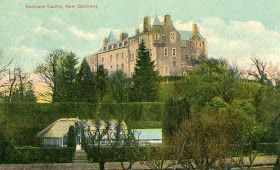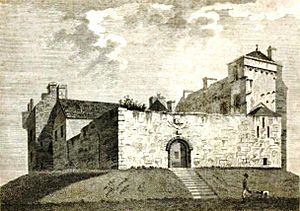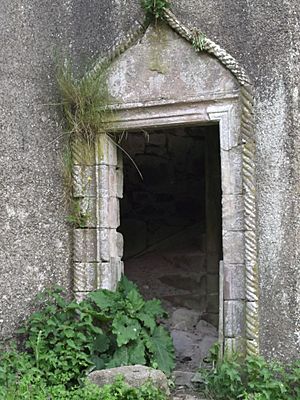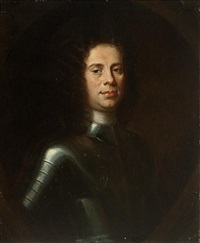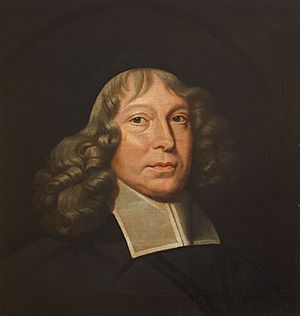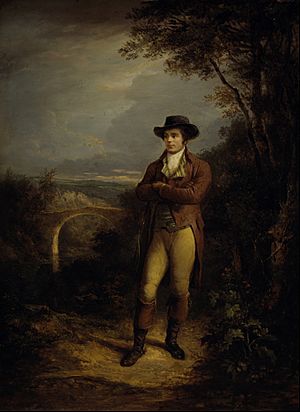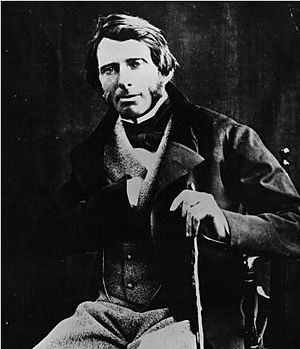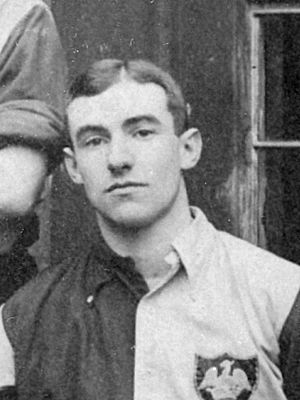Kenmure Castle facts for kids
Kenmure Castle is a strong castle located about 1 mile south of New Galloway in south-west Scotland. People have lived on this spot since the Middle Ages. The castle you see today includes parts of a 17th-century building. It was changed a lot in the 1800s. However, the castle has been empty and falling apart since the mid-1900s. Kenmure Castle was once the home of the Gordon family. They later became important nobles known as the Viscounts of Kenmure. Today, the ruins are a protected historic site.
Castle History
The castle stands on a natural hill. This hill might have been made stronger for defense a very long time ago. The Lords of Galloway were powerful rulers of a special kingdom in south-west Scotland. They might have had a fortress here before the 1200s. Some people think that John Balliol, who later became King of Scotland, was born here in 1249. His mother, Dervorguilla, was the daughter of Alan, the last independent Lord of Galloway. Later, the castle belonged to the Douglas and Maxwell families.
The Gordon family took over Kenmure in 1297. They had moved there from Berwickshire. The Gordons also built a castle on an island in Lochinvar, about 6 miles north. James IV of Scotland visited Kenmure in March 1508. He was returning from a religious journey to Whithorn. The king played a game similar to backgammon while he stayed. He also gave money to the castle's servants.
The early castle at Kenmure was owned by Sir John Gordon of Lochinvar. It was damaged or destroyed by enemies of Mary, Queen of Scots. These enemies marched through the area after winning the Battle of Langside in 1568. A list of all the furniture and items in Kenmure Castle was made on December 3, 1604.
Sir Robert Gordon of Lochinvar was given the title of baronet in 1626. In 1633, his son Sir John Gordon was made the first Viscount of Kenmure by King Charles I. The main part of the castle today was built in the 1600s. It might even include older parts. The castle was built on the west and south sides of a courtyard. High walls formed the north and east sides. The main gate in the north wall had towers on either side.
The 6th Viscount joined the Jacobite Rising of 1715. This was a rebellion against the king. He was later executed, and his lands were taken away by the king. Some stories say his body was brought back to Kenmure for burial.
By 1790, Kenmure Castle was described as a ruin.
The title of Viscount was given back to Captain John Gordon in 1824. He passed away in 1840. The title stopped being passed down after his nephew, Adam, the 8th/11th Viscount, died in 1847. The castle was greatly changed and made more modern during the 1800s. The courtyard wall and the north-east tower were removed using gunpowder. The south part of the castle was rebuilt around 1840.
Architects like William McCandlish and Hugh Maclure worked on the castle in the 1840s and 1860s. Matthew Ellison Hadfield remodeled the west side in 1879. More additions were made in 1908 by Christian Elliot.
In 1923, the estate was sold. However, the castle itself was rented and later bought by Brigadier-General Maurice Lilburn MacEwen. He was a commander in the local Home Guard during World War II. He died at Kenmure Castle in 1943. From the late 1940s to 1957, the castle was a hotel. Around 1958, everything inside the building was taken out, and the roof was removed. Graeme Gordon bought the ruins in 1962. The castle was not destroyed by fire, as some people believe. The castle's remains were listed as historic in 1971 and protected in 1998. People say the castle is haunted by a headless piper.
A sundial from Kenmure, dated 1623, is now in Dumfries Museum.
Famous Visitors
Many interesting people visited Kenmure Castle over the years:
- George Gillespie (1613–1648) was a Scottish religious leader. He was the private religious advisor to John Gordon, the 1st Viscount Kenmure.
- Rev Prof Samuel Rutherford (around 1600–1661) was a Scottish pastor and writer. He was with John Gordon, the 1st Viscount Kenmure, when he died. Rutherford later wrote a book about it called "The last and heavenly Speeches and glorious Departure of John, Viscount Kenmure."
- The famous poet Robert Burns and his friend John Syme stayed at the castle for three days in July 1793. They were guests of the owner, John Gordon.
- Rev Robert Nixon (1759–1837) was a Church of England priest and artist. For the last ten years of his life, he was the private religious advisor to Viscount Kenmure at the castle. He died there in 1837. His son, Francis Russell Nixon, became the first Bishop of Tasmania.
- John Ruskin (1819–1900), a famous art critic and writer, stayed at Kenmure in 1876. He was visiting his cousin Joan Agnew and her husband, the artist Arthur Severn.
- Cowan Dobson (1894–1980), a Scottish portrait painter, is said to have rented the castle in the 1930s and 1940s. He used it to entertain guests and paint his portraits.
- Charles Tate Regan (1878–1943) was a fish scientist from the Natural History Museum. He studied the skeleton of a very large pike that was caught in Loch Ken below the castle in 1774. The pike weighed 72 pounds and was about seven feet long! The skeleton of its head was kept in the castle's Billiard Room for many years.


